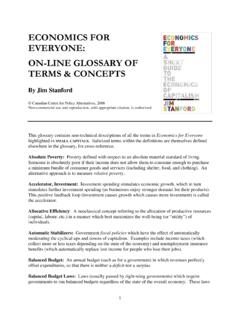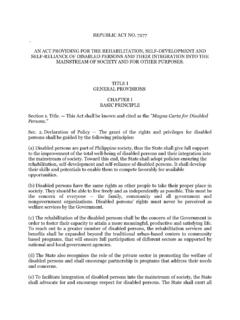Transcription of Impact of COVID-19 on working household incomes
1 Impact of COVID-19 on working household incomes : distributional analysis as of May 2020. July 2020. Impact of COVID-19 on working household incomes : distributional analysis as of May 2020. July 2020. Crown copyright 2020. This publication is licensed under the terms of the Open Government Licence except where otherwise stated. To view this licence, visit government-licence/version/3. Where we have identified any third party copyright information you will need to obtain permission from the copyright holders concerned. This publication is available at: Any enquiries regarding this publication should be sent to us at ISBN 978-1-913635-39-8 PU 2975. Contents Chapter 1 Impact of COVID-19 on working household incomes 2. 1. Chapter 1.
2 Impact of COVID-19 on working household incomes This document sets out the estimated distributional impacts of COVID-19 on working households' incomes , as of the end of May 2020, according to emerging household survey data. Specifically, it sets out the Impact of government support against the Impact of earnings and job losses, comparing incomes in May 2020 to what they were in February this year. As the economic impacts of the pandemic and the corresponding government support have predominantly affected the incomes of working households, we have shown the impacts across the income distribution of these households only. This is an ad hoc publication, separate from the distributional analysis normally published alongside fiscal events, which we are presenting here in order to illustrate the full scale of the challenge faced by working households and where government support has helped mitigate these challenges.
3 Only those government interventions implemented up to the end of May 2020, the latest date for which suitable data on household income changes is available, are captured in the analysis (and as such it does not estimate the distributional Impact of the package of measures announced as part of the Plan for Jobs). The analysis presented here shows the estimated short-run change in working households' net incomes between two points in time, as well as those government interventions that have a direct, quantifiable Impact on households. It does not capture the potential long-run impacts of the pandemic on households, and does not make any assumptions about what household incomes might have looked like in the absence of the pandemic.
4 Charts and split out the estimated change in net household income for working households only, from February to May 2020, into employment and earnings losses, and additional government support. Chart shows these impacts as a proportion of net household income in February, while Chart is expressed in weekly cash terms. The Coronavirus Job Retention Scheme (CJRS) provides employers with grants to help pay the wages of furloughed employees. The charts illustrate both the increase in earnings paid for through these grants, and the corresponding reduction in earnings paid directly by employers. Note that the Self-Employment income Support Scheme (SEISS) has been paid as a single grant from May, equivalent to 80% of quarterly trading profits, capped at 7,500.
5 To present the SEISS in its wider context, and allow for a 2. reasonable comparison with the CJRS, the SEISS is treated in this analysis as a monthly payment, capped at 2,500. Further detail on the approach taken is set out in paragraph The charts show that government interventions since March have: supported the poorest working households the most (as a proportion of February income ). been worth around a fifth of incomes for working households (on average). reduced the scale of losses for working households by up to two-thirds Chart : Percentage change in household income , by working household net income decile, as of May 2020. 40%. 30%. 20%. 10%. 0%. -10%. -20%. -30%. -40%. Bottom 2 3 4 5 6 7 8 9 Top All Decile Decile working house- Equivalised Net income Decile holds COVID-19 additional welfare support Self-Employment income Support Scheme (SEISS).
6 Coronavirus Job Retention Scheme (CJRS). Existing tax and welfare stabilisers Earnings and job losses Hypothetical earnings losses for furloughed employees in the absence of the CJRS. Overall % change in working household net incomes from February 2020. Source: HM Treasury distributional analysis model 3. Chart : Change in household income , per week, by working household net income decile, as of May 2020. 400. 300. 200. 100. 0. - 100. - 200. - 300. - 400. - 500. - 600. - 700. Bottom 2 3 4 5 6 7 8 9 Top All Decile Decile working house- Equivalised Net income Decile holds COVID-19 additional welfare support Self-Employment income Support Scheme (SEISS). Coronavirus Job Retention Scheme (CJRS). Existing tax and welfare stabilisers Earnings and job losses Hypothetical earnings losses for furloughed employees in the absence of the CJRS.
7 Overall change in working household net incomes from February 2020. Source: HM Treasury distributional analysis model Methodology The ad hoc analysis presented here is based on HM Treasury modelling, using data from the COVID-19 survey modules conducted by the long-running UK. household Longitudinal Study (UKHLS) in April and UKHLS is a broadly representative household survey of the same individuals in the UK each year (starting in 2009) and contains detailed information on individual and household characteristics. The COVID-19 modules are short web-based surveys, covering the Impact of the pandemic on the welfare of UK individuals and families, varying across areas such as health and wellbeing, to employment and financial outcomes.
8 1 4. The probability of individuals of different earnings levels losing their job, being furloughed, or seeing an earnings/profit drop is first calculated from the UKHLS data, comparing employment status (and average change in take- home pay) in May with Using these individual-level probabilities, we then simulate a similarly sized employment and earnings shock using HM Treasury's distributional analysis model (the Intra-Governmental Tax and Benefit Microsimulation model (IGOTM)), accounting for the offsetting Impact of higher benefit receipt and lower tax payments. Baseline earnings and employment levels are taken from the Office for National Statistics' Living Costs and Food Survey, the dataset underlying the IGOTM model.
9 We have also assumed the proportion of welfare claimants in February on Universal Credit and legacy benefits respectively is as set out in the Office for Budget Responsibility's March 2020. Economic and Fiscal Outlook, alongside DWP estimates of total steady-state welfare claimants. New welfare claimants since February are assumed to have claimed Universal Credit. We then model the Impact of additional government support provided to mitigate these shocks, specifically: the Coronavirus Job Retention Scheme (CJRS). the Self-Employment income Support Scheme (SEISS). temporary increase in the Universal Credit standard allowance by 20 a week temporary increase in the basic element of working Tax Credit by 20 a week temporary suspension of the Minimum income Floor in Universal Credit increase in the Local Housing Allowance to the 30th percentile of market rents in 2020-21.
10 The Existing tax and welfare stabilisers' bars in Charts and reflect the net Impact of lower taxes and increased benefit entitlement from job and earnings losses, offset by higher taxes received from CJRS and SEISS payments (as these grants are subject to income Tax and National Insurance). Only those interventions that have a direct, quantifiable Impact on household incomes have been included in the analysis. We have therefore excluded measures that have mainly been targeted at business (such as the Coronavirus Business Interruption Loan Scheme (CBILS)), as well as any additional public service spending. A few relatively smaller measures, such as the removal of the seven-day wait in Employment and Support Allowance (ESA), have also been excluded from the analysis.

















